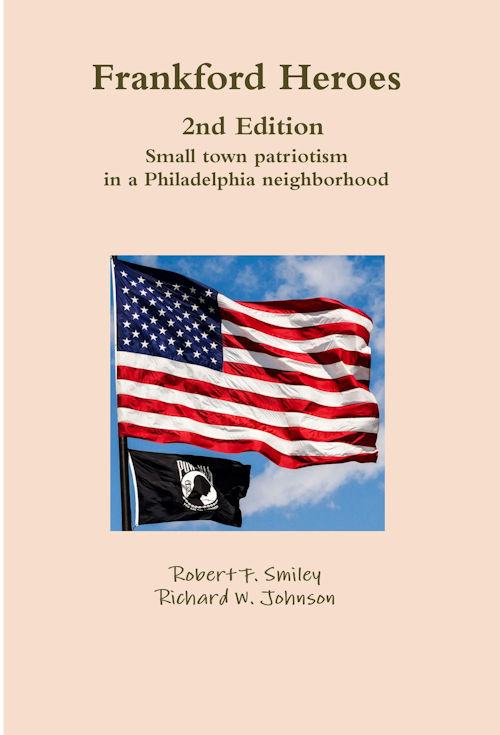My parents moved their family from Germantown to the Northwood section of Frankford, to one of the side-by-side twins on Wakeling Street across from Frankford Stadium, in 1956.
By the early 1960s, I and my brothers were among the little “street urchins” playing “kick-the-can,” step ball and Wiffle ball (not to mention a rather brutal hand ball game with the off-color name “a – – es-up”) on Rutland Street between Wakeling and Allengrove Streets with Nicky Macko, Judge Dwyer’s son Kevin Dwyer, Henry Hudson, Francis Harding, Dennis and Daniel Grassi, and others.
One day, I think around 1962, when I was 9, Dennis Grassi invited me to the garage behind their home at Harrison and Large Street, catacorner from Harrison Grocery.
“You gotta see my collection of Indian marbles!” he told me with that endless enthusiasm about the little things that only kids can have (or those of us who never grow up).
“Indian what?” I asked.
“Indian marbles! Indian marbles!” he answered proudly. “Who do you think the people of America learned to play marbles from?”
Dennis opened the door to his garage, where his dangerous giant pet snapper turtle sat in the kid’s wading pool chomping on lettuce, and we went to one of the back corners of his garage where Dennis extracted a shoe box from a trunk. He lifted it out carefully with both hands, laid it on the floor, and opened the top. Inside the box was something which most people today — in fact, something which most paleontologists today — would describe as a “remarkable collection”: Approximately 100 mostly-spherical white stones, ranging from the size of a dime to the size of a silver dollar.
“The Indians made ’em, so that their kids could play marbles!” Dennis explained. “I found almost all of ’em in the dirt down in the back of The Lot — you know, where it slopes-off into that big gulley between the back of the garages and the railroad tracks?”
The Lot — where the tennis courts are now on Harrison Street between Rutland Street and Castor Avenue — was the place where we had most of our fun as kids. I knew exactly where this “big gulley” in The Lot that Dennis was referring to was located. See Map, below. I wrote about The Lot before, in a prior article. See
http://gloomyhappy.wpengine.com/2011/09/18/the-terrifying-railroad-staple-machine-guns/
I could hardly contain my enthusiasm after hearing Dennis’ story and viewing and touching his collection of “Indian marbles.” “WOW,” I thought, “A real Indian toy! Dug up out of the ground!” For a kid, an impossibly wonderful thing: A type of buried treasure. I knew that if I didn’t do something about this immediately, I would explode and die.
I went down to The Lot that day with an old claw hammer, and started digging and digging and digging with the nail-pulling side of the hammer, and — I couldn’t believe it — I found one! A real “Indian marble”!
 I kept an eye out for “Indian marbles” for the rest of my life, after that. I still do. Even as a kid I learned that the best place to look for them is in an area where there is heavy erosion, and that the best time to look for them is in the Fall or Winter or early Spring after a heavy rain, when soil is not being held in place by roots, and the flow of water has bared the tops of the Indian marbles, so that they glisten in the Sun. So, even when I wasn’t digging for them in The Lot, I used to find them in the mud along Frankford Creek just north of the Fishers Lane Bridge on the west bank of the creek. I also found them at excavation sites throughout Frankford, where the excavated dirt, when it was rained upon, immediately exposed its “Indian marbles.”
I kept an eye out for “Indian marbles” for the rest of my life, after that. I still do. Even as a kid I learned that the best place to look for them is in an area where there is heavy erosion, and that the best time to look for them is in the Fall or Winter or early Spring after a heavy rain, when soil is not being held in place by roots, and the flow of water has bared the tops of the Indian marbles, so that they glisten in the Sun. So, even when I wasn’t digging for them in The Lot, I used to find them in the mud along Frankford Creek just north of the Fishers Lane Bridge on the west bank of the creek. I also found them at excavation sites throughout Frankford, where the excavated dirt, when it was rained upon, immediately exposed its “Indian marbles.”
What exactly are these things which we called “Indian marbles”? It turns out that they are probably gastroliths — gizzard stones swallowed by large sauropod dinosaurs like the brachiosaurus and the diplodocus — remember the “veggie-saurs” in the first Jurassic Park movie, with the long necks and tails, with the fat bellies in between? — to aid in the crushing of food in their digestive tracts.
Thus, my words above, in talking about Dennis Grassi’s “Indian marble” shoe box: “Something which most paleontologists today would describe as a ‘remarkable collection.’ ” Probably, his shoe box of “Indian marbles” should have been on display down on the Parkway, in the Museum of Natural History.
Haddonfield, New Jersey, had its famous Hadrosaurus fossilized skeleton. Frankford had its Jurassic gastroliths.
In the early 1970s, I gave Howard Barnes over at the Historical Society my collection of about a dozen “Indian marbles” and some paleo-Indian tools I had found down by Frankford Creek. I’ll talk more about those tools later, in another article.




